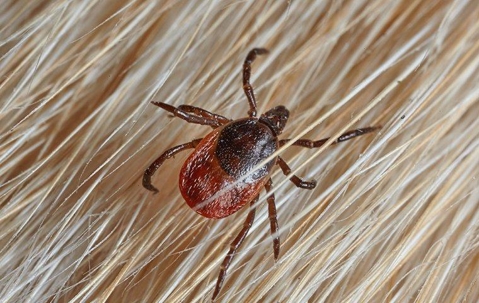Afraid of ticks? You should be. These tiny arachnids are notorious for their ability to spread dangerous diseases, including Lyme disease, Rocky Mountain spotted fever, and others. They are difficult to spot, harder to remove, and dangerous to humans and other animals alike. Four types of tick are commonly encountered in Davenport, and each pose slightly different threats to humans and their pets.
Four Ticks Found In The Davenport Area
American Dog Tick
Occasionally known as the wood tick, American dog ticks are the most frequently encountered tick species. Their appearance varies depending on the gender of the tick. Females have a colored spot behind their heads and swell up to the size of a tiny grape after feeding. Males have silver lines instead, and they don’t swell up after feeding. Both are 3/16th of an inch and reddish-brown when they haven’t fed. This tick is known to spread Rocky Mountain spotted fever and tularemia.
Lone Star Tick
These ticks are usually spotted in the Southern half of the state. Lone star ticks are much smaller than dog ticks (nymphs reach the size of a pinhead, and adults are only 1/8th of an inch) and brown-colored. They are often incorrectly identified as a blacklegged tick because of their similar size. Females have a light brown spot on their back which earned them their name. The lone star tick tick most commonly spreads ehrlichiosis, and
Southern Tick Associated Rash Illness (STARI)
Blacklegged Ticks/Deer Ticks. These ticks are the size of lone star ticks (1/8th of an inch at their adult stage) and the color of American dog ticks (reddish-brown). The main difference is that Blacklegged ticks feed on a variety of hosts during their larvae and nymph stages, but primarily feed on deer in adulthood. This tick will transmit diseases such as Lyme, babesiosis, and Powassan virus to humans and animals.
Brown Dog Tick
As their name suggests, these ticks tend to feed on dogs over humans. They are the same as the American dog tick appearance-wise, but they are not able to survive cold winters like their counterparts. It may transmit Rocky Mountain spotted fever, canine babesiosus, and canine ehrlichiosis to its host.
Identifying A Tick Bite In Davenport
The easiest way to know if you, a family member, or a pet were bitten by a tick is to find the tick itself. They can feed for long periods of time, so you’ll be able to spot them before they drop off. If a tick fell off before you found it, you will usually see a bright red or dark spot that swells.
If a rash breaks out, it will look like a “bullseye” mark with a large ring around it. A rash usually indicates that the tick spread a disease, like Lyme’s disease or worse, so seek immediately medical attention if you find this rash. If your pet was bitten, you may notice fatigue, swelling, red skin, or lack of appetite. If you notice any of these symptoms, your pet likely has an infection and will need to see a veterinarian.
How Ticks Move Around And Feed In Davenport
Ticks are not able to jump. They move about by crawling. They cling onto blades of grass or shrubs and then attach to animals, pets, and humans that pass by. Once they’re on a host, they’ll crawl around to find warm, exposed skin and begin feeding. You can find them anywhere on an animal or human, but they sometimes hide in warmer areas of the body. After feeding, female ticks will usually drop off and lay thousands of eggs.
Tick Prevention Methods In Davenport
- These days, ticks in your yard seems practically inevitable. There are, however, some preventative measures you can take to make them less likely to be on your property.
- Regularly trim your lawn and shrubs.
- Stay on trails and paths when travelling in the wilderness.
- Cover exposed skin with long pants and shirts when in the woods. Tape openings to prevent ticks from crawling underneath.
- Wear light colored clothing
- Spray your clothing with a bug spray or wear pre-treated clothing to deter ticks.
- Lastly, always inspect pets and children carefully when they come inside.
If you do find a tick, remove it with tweezers or a tick removal tool. Pull the body straight up without twisting. Make sure the head was not left behind and use antiseptic wipes to treat the bite wound. If you have never removed a tick, its best to contact a professional or ask someone with experience to help.
The Professionals Can Help
Our experienced and licensed technicians at Quik-Kill Pest Exterminators understand how dangerous ticks can be. We offer solutions to control your tick population and will be more than happy to discuss tick prevention tips with you. Keep your family safe from ticks – call Quik-Kill Pest Exterminators today.

